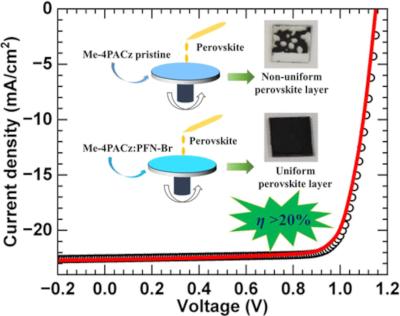Researchers from the Indian Institute of Technology Bombay and Germany's Helmholtz Young Investigator Group FRONTRUNNER IEK5-Photovoltaik have designed an inverted perovskite solar device that uses a self-assembled monolayer to suppress nonradiative recombination at the interface between the perovskite absorber and the hole transport layer. The team reported high efficiency for the cell and say it was also able to retain the initial efficiency rating for 3,000 h.
The inverted perovskite solar cell was based on a hole transport layer (HTL) made of a phosphonic acid called methyl-substituted carbazole (Me-4PACz).
Inverted perovskite cells have a device structure known as “p-i-n”, in which hole-selective contact p is at the bottom of intrinsic perovskite layer i with electron transport layer n at the top. Conventional halide perovskite cells have the same structure but reversed – a “n-i-p” layout. In n-i-p architecture, the solar cell is illuminated through the electron-transport layer (ETL) side; in the p-i-n structure, it is illuminated through the hole‐transport layer (HTL) surface.
The team explained that their approach ensures that electronic Fermi-level can be tuned according to absorber layer bandgap and so should be highly useful for tandem solar cells applications. It also provides an added advantage of wettability of halide perovskite solution to provide a compact, reproducible and scalable layer.
The scientists explained that the Me‑4PACz HTL is a self-assembled monolayer (SAM) that is able to suppress nonradiative recombination at the interface between the perovskite absorber and the Me‑4PACz layer.
The solar cell has an active area of 0.175 cm2. It is based on a substrate made of glass and indium tin oxide (ITO), an interfacial layer made of the PFN polymer, the Me‑4PACz HTL, the perovskite absorber, an electron transport layer (ETL) made of phenyl-C61-butyric acid methyl ester (PCBM), a bathocuproine (BCP) buffer layer, a tin(IV) oxide (SnO2) layer, and an indium zinc oxide (IZO) transparent conductive oxide film.
Tested under standard conditions, the cell achieved a power conversion efficiency of 20.7%. The team stated that it believes that the obtained device efficiency is one of the highest values reported for Me‑4PACz with a triple-cation perovskite composition having a bandgap of 1.6 eV.
The mixing engineering of the Me‑4PACz SAM with the electrolyte polymer PFN‑Br could not only open new doors to tackling hydrophobic SAMs in solution-processable efficient photovoltaic devices but also allow designing new electrolyte-based polymers and/or small molecules that can be combined with SAMs, for achieving better interfaces.




